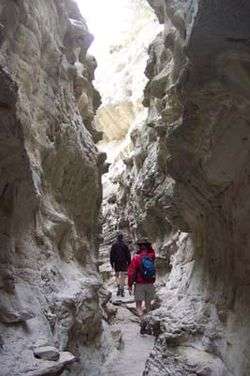Ravine

A ravine is a landform narrower than a canyon and is often the product of streamcutting erosion.[1] Ravines are typically classified as larger in scale than gullies, although smaller than valleys.[1]
Definition
A ravine is generally a fluvial slope landform of relatively steep (cross-sectional) sides, on the order of twenty to seventy percent in gradient. Ravines may or may not have active streams flowing along the downslope channel which originally formed them; moreover, often they are characterized by intermittent streams, since their geographic scale may not be sufficiently large to support a perennial watercourse.[2]A ravine is a deep valley which is formed due to linear/dendritic fluvial erosion of loose unconsolidated and bare soils by intricate network of rills and gullies.
Other terms for ravine include
- cleuch
- dell
- ghout (Nevis)
- gill or ghyll
- glen
- gorge
- Gravina in Puglia
- kloof (South Africa)
- chine (Isle of Wight)
Notes
- 1 2 Definition of "ravine" at Merriam-Webster
- ↑ Christopher G. Morris; Academic Press (1992). Academic Press Dictionary of Science and Technology. Gulf Professional Publishing. pp. 1802–. ISBN 978-0-12-200400-1. Retrieved 1 October 2012.
Other web to find the definition (Definition.com)
